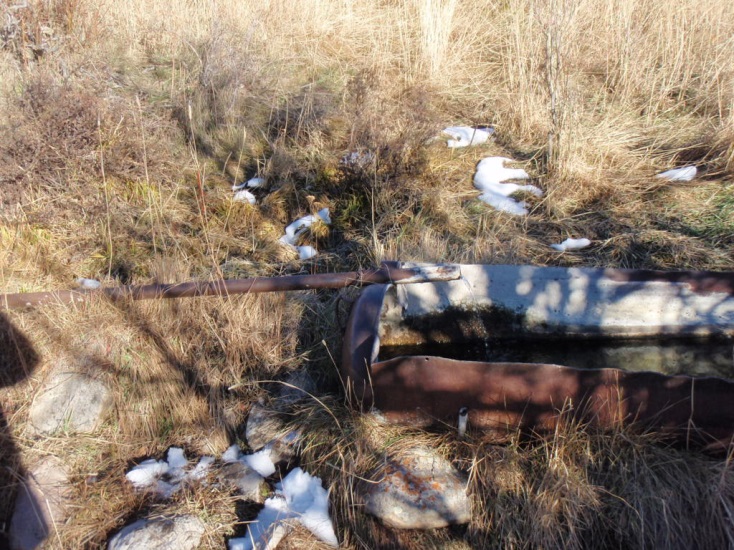Standing on the side of a mountain, with a magnificent vista of the Blue River Valley behind us, we stare at the bottom of a large tractor tire plumbed to hold water. After opening the main valve, we wait for the flow of water to appear and begin filling the tire tank. After a moment of gurgling, the water pours out of the pipe. We all smile. It is a good feeling to see a tank fill up with water for the first time.
This tire tank is part of a project to deliver water to livestock and big game and, in the process, enhance habitat for Greater Sage-Grouse on the Yust Ranch, located in Colorado’s high country just west of the Continental Divide. The Yust Ranch hosts an active Greater Sage-Grouse lek and encompasses a large, undeveloped portion of the south end of Middle Park in Grand County. The area around the ranch has experienced significant development in the past few decades thanks to prime Colorado ski country just a 30-minute drive south. With the third-largest Greater Sage-Grouse population in Colorado located in Middle Park, projects to conserve grouse habitat on private lands in the park are critical.
Jay Yust is a fifth-generation rancher in Middle Park. His family has operated Yust Ranch, a homestead, for many decades in the ruggedness of Colorado’s high country, an impressive feat. The Yust Ranch is a working cattle ranch that sustains diverse wildlife habitat. It is an awe-inspiring place to work.

This is the view from the Yust Ranch looking south into the Blue River Valley near the project site. The Yust family has operated a ranch on the property for five generations. Photo by Jim Yust.

This is the view from the Yust Ranch looking north into Middle Park. Along with Greater Sage-Grouse, Dusky Grouse and Columbian Sharp-tailed Grouse are also found on the ranch. Photo by Noah Bates.
Water is often a limiting factor for access to significant amounts of underutilized forage for livestock. This forage is often outside of – or at the fringe of – occupied Greater Sage-Grouse habitat. On the Yust Ranch, the east half of the ranch is occupied by Greater Sage-Grouse, while the west half is unoccupied due to higher elevations and forest stands. This project is designed to deliver water to an area that is unoccupied by grouse but has been underutilized by livestock due to limited water and topography. By making this area viable for livestock, we have more options for working grazing rotations to keep cattle off occupied Greater Sage-Grouse habitat during certain times of year. In mountainous country, options for grazing are often limited, as snow can linger into July in higher elevation pastures and areas can become too saturated with water for cattle to access in the early season.
The project, a partnership between the Yusts, RMBO and Middle Park Habitat Partnership Program, involved connecting new pipe to existing hand-built rock house water collection sites. The collected water is delivered to a stock tank at the top of a high bench and also delivered to a stock tank at the bottom of the bench by 1,200 feet of pipe buried in a trench on a steep, rocky slope. There were lots of ways for the project to go awry, such as the excavator slipping and rolling down the slope, but fortunately everything went right! Rancher Jay Yust figured this was the most difficult water to develop on the ranch, and implementing other water projects will be relatively easy after this one.

This old tank, developed to hold water for livestock, had low capacity. Photo by Noah Bates.

Jay Yust cuts the original collection pipe at the rock house to attach new pipe. Photo by Noah Bates.

Tim Bock, of Bock Construction, excavates a trench down a steep, rocky slope to bury 1,200 feet of pipeline to supply a planned stock tank at the bottom of the bench. Photo by Jim Yust.

Toby Hargadine prepares the bottom stock tank for plumbing, while Angus the dog inspects the inside of the tire. Photo by Jim Yust.

The upper tank, a tractor tire cut in half with inlet and outlet plumbed through the bottom with a concrete plug, is located at the top of a steep slope. Ranchers tend to like tire tanks because they are indestructible and will last a lifetime. This photo was taken before a stock tank ladder was installed. Photo by Noah Bates.
Projects like this one provide multiple benefits for both ranchers, such as Jay Yust, and wildlife, such as the Greater Sage-Grouse. They’re a win-win, helping both the ranch and wildlife thrive. Rocky Mountain Bird Observatory, in partnership with the NRCS Sage Grouse Initiative, Middle Park Habitat Partnership Program and U.S. Fish and Wildlife Service: Partners for Fish and Wildlife, will continue working with Jay Yust to enhance his ranch for grouse and other wildlife. Plans include implementing additional water projects, replacing old fencing with wildlife-friendly designs, improving water delivery for grass hay production, and developing a grazing management plan that will provide necessary forage for livestock while maintaining quality sage-grouse habitat.
~ Noah Bates, Private Lands Rangeland/Wildlife Specialist


